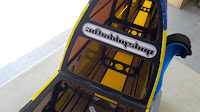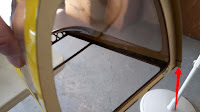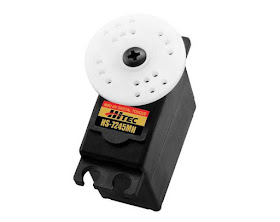Right at about a year ago, Extreme flight began releasing some of their own brand of hardware and accessories under the Xcessories name. At the time is was one or two accessories, but now it's grown to where we need to roll it out there and show you all of the Xcessories that make life easier and the build of any project go more smoothly. Every Xcessory is top quality, which makes sense because we will be using them on the most top quality planes. There is not a lot of sense in building a top quality plane and then using junky accessories to finish it off. For one thing it looks cheesy and out of place, but more importantly, poor quality accessories can sometimes fail and cause you bigger problems, like a nasty crash. It gets back to the weakest link in the chain, and with Xcessories, the last weak link has been eliminated.
One huge advantage to the Xcessories lineup is that you can now order absolutely everything you need for your new plane when you order it. You only have to order from one plane, it all comes in one box, and you only have to pay one shipping price. That last part alone can save you a lot of money.
One huge advantage to the Xcessories lineup is that you can now order absolutely everything you need for your new plane when you order it. You only have to order from one plane, it all comes in one box, and you only have to pay one shipping price. That last part alone can save you a lot of money.
There are a lot more quality Xcessories that I am going to cover here. As a 48-60" span specialist, I don't really fly larger or gas powered planes, but Xcessories has part for those planes too like the excellent Blazing Star engine mounts and Flo Master fuel tank
Xcessories Rockin' New Extended Servo Arms
The harder we started pushing these planes, the more we had to look at improving areas of performance. Part of this naturally led us to a critical look at the servos and linkage system. When you use a long arm, anything wrong in the linkage system is greatly amplified. We are running at least four times as much (and sometimes more) throw than you would run on a sport plane, so if you have something like a draggy ball link or sloppy servo arms, problems with getting the control surface to center are going to be about four times as bad as you would normally expect. This is simply unacceptable.
Years ago we went to ball link connectors on both ends of the pushrod to assure drag free and slop free connection and smooth operation. This was a big step forward, but then we needed to look at the servo arms too. We were getting a lot of slop in the plastic arms we were previously using. The plastic splines would spread out under load and then the servo arm could wobble around on the servo output shaft. Now, we have slop in the linkage system again, which affects centering of the control surface. The servo will center fine on it's own, but with slop in the pushrod system the surface may or may not. This makes trimming the plane for precision maneuvers virtually impossible, and you'll spend the entire flight either fighting a plane that won't stay trimmed, or chasing the trims the whole time. Neither way is not much fun.
I tried a few aftermarket metal arms too, but no one made an arm that uses the 2mm hardware that comes with the Extreme Flight 48-60" span kits. Basically we were stuck with plastic arms unless we wanted to special order expensive custom arms from a specialty manufactures and pay postage on top of it.
Now Extreme Flight is making their own Xcessories Beautiful anodized light weight aluminum arms. They are pretty light, and I am guessing they might even be lighter than the plastic arms we were using before. The holes in the arms are 2mm, so you just bolt the ball link on and forget about it. You don't have to drill anything or measure anything.
Metal arms I have tried previously were very difficult to get onto the servo because the splines were so tight, and getting them off was a problem too. The Extreme Flight arm seems to be just right in that it goes on easily with a little gentle pushing, secure the center mounting bolt, then sock it down tight as a clam using the allen cinch bolt on the side. Other arms I have had to pry off with a screwdriver, but with the Extreme Flight arm you remove the center mounting bolt, loosen the cinch bolt, and after some gentle wiggling it pops right off.
These arms fit the spline pretty well to begin with, but once you tighten the cinch bolt there is less than zero slop. It's on there, and now I worry less about the bolt that actually retains the arm falling out and the arm popping off. I think the arm would stay on without it, but I'm still going to use one!
Also useful is the arm is tapped for a 2mm bolt where the ball link is attached on, so you could probably get away with a little locktite and just crank the bolt down. I'm still the paranoid type and will use a locking nut and some medium CA on the back side, just to be dead solid sure.
These arms are going to make the entire control system much more rigid with much better control centering. Essentially, these arms are going to make the plane fly better. With the threaded bolt holes and cinch bolt, everything will be easier to set up, work on and maintain too.
I plan to retrofit all of my 60" EXPs. These are far and away the best servo arms I have ever tried, and they are really reasonably priced between $5.88 and $11.00. These arms are massive winners in every conceivable way. Xccessories' also makes these arms in larger sizes for bigger planes.

Xessories Servo Extensions
Another one of these products you buy almost every time are servo extensions, and now Extreme Flight makes their own Xcessories Servo Extensions as well. These are really nice twisted extensions available in all the sizes you see listed on the link above. Something else that's nice is every plane's order page lists the extensions you will need, so this cuts down on the guessing.I got a giggle out of the packaging because it's really too nice for something like this. Usually you just rip the bag open and toss it because you want to get on to the build, but this little bag actually has a re-sealable opening at the top! You have to wonder why Extreme Flight made such nice packaging, but my guess is that this is just a part of the quality experience you get with the new line of Extreme Flight accessories.
As you can see, the leads are twisted, which looks nice. The best part is they are the right length, so I don't have a bunch of wire flapping around inside the plane and the installation looks neat and tidy, almost like I know what I am doing.

Xessories Socket Head Servo Arm Bolts
We all hate the awful Phillips head bolts that come with servos to hold the servo arm on. The head of the screwdriver will spin inside the phillip head unless you apply a lot of downward pressure, and you can easily crack (or worse, break) the wood behind the servo. We've also had plenty of Phillips slip off the end of the screwdriver and roll off into never-never land where they are never-never seen again. Using an allen head greatly reduces the changes of that happening, so that's what Xcessories made for us. To secure the arm to the servo, the HS5245MG and HS7245MH use a 2.6 X 8 mm bolt. These are available in an allen head from Xessories as HiTec Servo Arm Screws - Bag of 10
Xessories Socket Head Servo Screws For servo Mounting
Most servos come with Phillips head screws for mounting the servos. I much prefer to use an allen head screw because the allen tool plugs deep into the screw head, and this makes installing screws much easier.
I now use Xcessories Flight's' New Socket Head Servo Screws on all my planes, and I really like them. Check the photo above of the servo arm and you can see what the servo screws look like installed. It appears they are anodized in sort of a titanium color and I like to look much better than the chrome we usually get.
These are very easy to work with because they stay on the tool really well, and not always falling off and rolling under the work bench. You can also crank them down really good because an allen is less prone to rounding off than a Phillips. These are much, much, much easier to work with and a lot less aggravation than the Phillips heads screws that come with most servos.
I bought the big bag with 100 screws for $4.99. That's way cheaper than anything you can get from the local hobby shop. Most of the planes we fly take four servos, times four mounting screw per servo. That's 16 screws per plane, and 100 screws are enough to set up six planes with four left over if you are clumsy and drop things under the work bench.
Five bucks to set up six planes. Try getting that kind of value at the local hobby shop.
Xcessories Pilot X
Yes, this is the same Pilot X we have always loved, only now it is under the Xcessories umbrella. This way when you purchase something of the Extreme Flight, the Xcessories tab is pretty close to your one stop page for anything but the plane and power system, and makes navigating the site a snap.
These are just a few of the items that I have personally used. Also included under the Xcessories banner are Extreme Flight's Excellent spinners and other items. Check the website for all of them.




















































